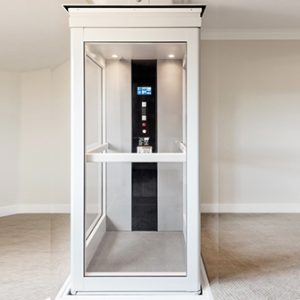Home elevators provide convenience, accessibility, and mobility to residential properties. Among the different types available, hydraulic home elevator is a popular choice due to their smooth operation and reliability. But how does a hydraulic Home elevator work?? Let’s take a closer look.

The Basics of Hydraulic Home Elevator
A hydraulic elevator operates using a piston and fluid-powered system to move the cab up and down. Unlike traction elevators that rely on cables and counterweights, hydraulic elevators use a hydraulic jack (a piston inside a cylinder) powered by an silent motor and hydraulic oil.
Key Components:
-
Hydraulic Motor Pump– Generates pressure by pushing hydraulic oil into the cylinder.
-
Piston/Cylinder Assembly – The piston extends or retracts to lift or lower the elevator cab.
-
Hydraulic Fluid Reservoir – Stores the fluid needed for smooth operation.
-
Control Valve – Regulates fluid flow to ensure a steady and safe ride.
-
Safety System – Includes emergency brakes and UPS backup power options for reliability.

How It Works: Step by Step
-
When You Press the Control Button:
-
The control system signals the silent motor pump to start.
-
The motor pushes hydraulic oil from the reservoir into the cylinder.
-
-
Ascending (Going Up):
-
The pressurized oil forces the piston to extend, lifting the elevator cab smoothly.
-
The control valve ensures the movement remains steady and controlled.
-
-
Descending (Going Down):
-
The valve opens, allowing oil to flow back into the reservoir.
-
Gravity helps lower the cab, while the valve controls the speed for a gentle descent.
-
-
Stopping at the Desired Floor:
-
The valve closes, stopping fluid flow and holding the cab in place.
-


Advantages of Hydraulic Home Elevator
✔ Smooth & Quiet Operation – Ideal for 2 and 3 floors residential use.
✔ Space-Efficient – Requires less overhead space than traction elevators.
✔ Reliable & Safe – Built-in safety mechanisms prevent sudden drops.
✔ Much Lower Cost – Often more affordable than other types for low-rise homes.
Maintenance Tips
-
Regularly check hydraulic fluid levels.
-
Inspect seals and valves for leaks.
Final Thoughts
Hydraulic home elevator provide a simple yet effective lifting mechanism, making them a great choice for homeowners seeking accessibility and comfort. With proper maintenance, they offer years of dependable service.
Interested in installing one? Contact us today for a free consultation!

